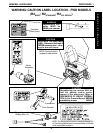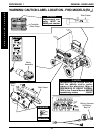
12
(+)
(-)
FIGURE 1 - FIELD LOAD TEST
Battery Charger
Connector
Digital Voltmeter
FIELD LOAD TEST (FIGURE 1)
NOTE: The following test can also be performed through
the controller of the wheelchair along with a remote pro-
grammer. Refer to the individual CONTROLLER
MANUAL supplied with each wheelchair.
Old batteries lose their ability to store and release power,
due to increased internal resistance. This means that as
you try to take power from the battery, some of that power
is used up in the process of passing through the battery,
resulting in less voltage at the posts. The more power
drawn, the lower the voltage available. When this lost volt-
age drops the output 1.0 volts under load (2.0 for a pair),
replace the batteries.
Testing under load is the only way to spot this problem.
While special battery load testing equipment is available,
it is costly and difficult to transport.
Use a digital voltmeter to check battery charge level at the
charger connector. It is located on the base of the wheel-
chair frame.
NOTE: READ the instructions CAREFULLY before us-
ing the digital voltmeter.
NOTE: Invacare recommends that ONLY qualified ser-
vice personnel perform this test.
1. Ensure that power is OFF.
2. Make sure battery is fully charged. An extremely dis-
charged battery will exhibit the same symptoms as a
bad one.
3. Place a one (1) piece of wood taller than the axle of
the drive wheels between the wheelchair and a wall,
workbench or other stationary object.
4. Remove the footrests from the wheelchair and place
the stabilizer wheels or the front of the wheelchair
against the piece of wood.
5. Place the voltmeter leads into the charger plug on the
wheelchair. Most digital voltmeters are not affected by
polarity, however, analog meters (meters with swing-
ing needles) can be and should be used carefully. A
good meter reading should be 25.5 to 26 VDC.
6. Have two (2) individuals (one [1] on each arm) apply
as much downward pressure as possible on the arms
of the wheelchair.
USING HYDROMETER TO CHECK
BATTERY CELLS (LEAD ACID)
(FIGURE 2)
NOTE: Perform this procedure when a digital voltmeter is
not available.
WARNING
NEVER smoke or strike a match near the
batteries. If the caps of the battery cells
are removed, NEVER look directly into
them when charging the battery.
The use of rubber gloves and safety glasses
is recommended when testing the battery
cells.
When reading a hydrometer, DO NOT al-
low any liquid to come in contact with
your eyes or skin. It is a form of acid and
can cause serious burns, and in some
cases, blindness. If you do get battery acid
on you, flush the exposed areas with cool
water IMMEDIATELY. If the acid comes into
contact with eyes or causes serious burns,
get medical help IMMEDIATELY.
The battery acid can damage your wheel-
chair, clothing, and household items.
Therefore, take readings cautiously and
only in designated areas.
TROUBLESHOOTINGPROCEDURE 2
This Procedure Includes the Following:
Field Load Test
Using Hydrometer To Check Battery Cells (Lead
Acid)
Motor Testing
Motor Brush Inspection
Electro-Mechanical Parking Brake Testing
7. Turn the wheelchair ON and push the joystick for-
ward, trying to drive the wheelchair through the sta-
tionary object. This puts a heavy load on the batteries
as they try to push through the stationary object. Read
the meter while the motors are straining to determine
the voltage under load.
NOTE: If the voltage drops to less than 23.5 volts from a
pair of fully charged batteries while under load, they should
be replaced regardless of the unloaded voltages.
T
R
O
U
B
L
E
S
H
O
O
T
I
N
G


















